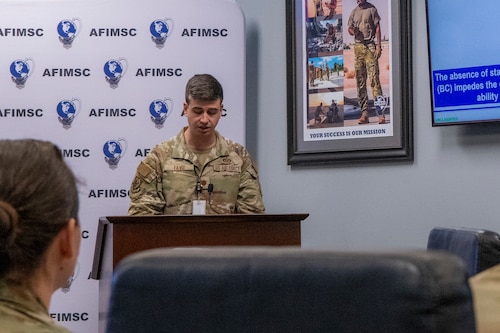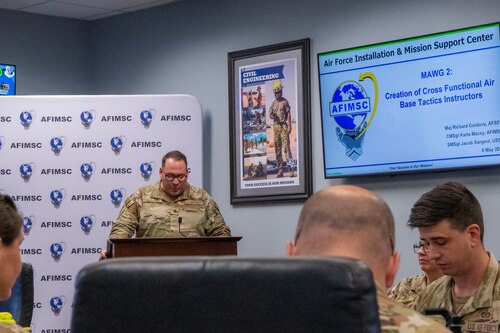The first of two 2024 Installation and Mission Support Weapons and Tactics Conferences concluded May 8 at the Air Force Installation and Mission Support Center in San Antonio, when three teams presented solutions to advance agile combat support operations in an era of Great Power Competition.
The I-WEPTAC 2024.1 Mission Area Working Groups briefed ideas for integrating combat support and combat service support capabilities to reshape, refocus and reoptimize the Department of the Air Force in these topic areas:
MAWG 1: Capabilities Within a Base Command - How to source the CS and CSS Airmen needed to stand up the proposed GPC units of action and the appropriate levels of support required at the installation given personnel and fiscal constraints.
MAWG 2: Creation of Cross-Functional Air Base Tactics Instructors - Build trusted advisors to help commanders achieve mission objectives and train cross-functional air base tactics instructors who will build, teach and lead combat support warfighters.
MAWG 3: Resilience and Base Recovery After Attack in an Agile Combat Employment Environment - How CS and CSS Airmen will recover a base after attack and the innovative ways to ensure combat resilience in an austere environment with minimal airlift and equipment support.
AFIMSC developed I-WEPTAC in 2017 and has hosted the conference ever since to provide a platform for I&MS Airmen and Guardians to engage in innovation.
"We have dedicated this particular I-WEPTAC to attributes of the hard GPC problems we're working on right now," said Maj. Gen. John Allen, AFIMSC commander. "Since I-WEPTAC is an Air Force innovation forum that takes on challenges facing installation and mission support agile combat support operations, it's the right platform for us to address GPC priorities. We're leveraging the innovative thought, expertise and 'group-think' of Airmen who conduct I&MS operations daily in order to harness that into actionable tactics, techniques and procedures we can field quickly."
Through collaborative efforts within cross-functional teams, participants tackle ACE challenges with a focus on enhancing personnel development, readiness, power projection and capability development. This involves thorough examination and crafting of strategic courses of action.
Maj. Conor Favo, Transportation Working Capital Fund program manager for AFIMSC Detachment 9 at Scott Air Force Base, Illinois, and chair for MAWG 1, said his team's efforts have been the same as previous MAWGs: developing combat support solutions to advance airpower. Therefore, the GPC focus was not a stretch for what the conference had been accomplishing.
"This MAWG is a driving force to represent the installation and mission support elements that are underway across the Air Force enterprise. It is a critical effort we wanted to continue with I-WEPTAC 2024.1," Favo said.
MAWG 2 focused on developing Airmen with the right expertise.
"Combat support Airmen play a pivotal role in providing essential support functions such as logistics, intelligence, communications and security," said Maj. Richard Cordova, MAWG 2 chair and chief of the Air Force Security Forces Center's Air Force Mission Assurance Team. "By establishing these roles, we can align our capabilities within the operations community to ensure better coordination, resource allocation and synchronization of efforts to enhance overall operational effectiveness."
MAWG 3 dealt exclusively with base resilience and recovery.
"Civil engineers are critical to the establishment and sustainment of air bases in any environment or conflict," said Maj. Robin Walton, deputy branch chief for the Air Force Civil Engineer Center's Facility Sustainment, Restoration and Modernization Program and MAWG 3 chair. "As we examine our various mission sets, we must continue to refine how we bed down, protect and sustain our forces."










